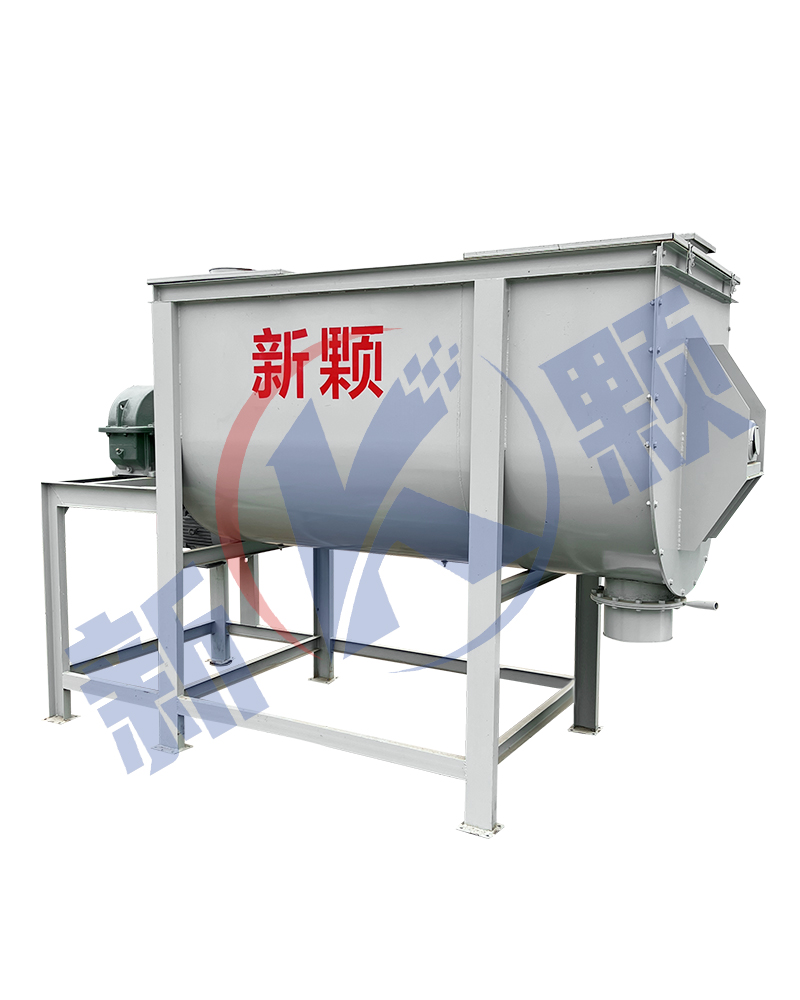



Horizontal mixer is a common mixing equipment that is widely used in many industries. The following is a detailed introduction:
1、 Structural composition
Stirring tank: generally a long tank placed horizontally, with a shape mostly in the form of a U-shape or a part of a cylindrical shape. The tank body is usually welded from steel plates, and its length, diameter, and other dimensions are determined according to different production scales and mixing requirements. For example, in large-scale feed production, the volume of the mixing tank can reach several cubic meters. There are feeding and discharging ports on both sides of the mixing tank. The feeding port is used to add various raw materials, while the discharging port is used to discharge the mixed materials.
Mixing shaft and mixing blades: The mixing shaft is horizontally placed inside the mixing tank along the length direction of the tank. The stirring blades are fixed on the stirring shaft and have various shapes and arrangements. Common mixing blades include paddle type, spiral belt type, etc. Paddle blades can generate radial and tangential flow of materials in the groove, achieving better mixing effect; Spiral belt blades can push materials to move axially, forming a circulating flow in the groove, especially suitable for long-distance material transportation and mixing.
Transmission system: including components such as motors, reducers, couplings, etc. The motor provides power for mixing, and the reducer is used to reduce the motor speed and increase the torque to meet the speed and torque requirements of the mixing shaft. The coupling connects the motor output shaft and the mixing shaft to ensure smooth power transmission. In addition, some horizontal mixers are equipped with belt transmission devices to achieve more flexible speed adjustment.
Supporting structure: mainly used to support components such as mixing tanks and mixing shafts, ensuring the stable operation of equipment. It usually includes a base and a bracket. The base is usually a thick metal structure placed on the ground to provide stable support for the entire equipment; The bracket is used to fix the mixing tank and support the mixing shaft, ensuring the concentricity and stability of the mixing shaft during rotation.
2、 Working principle
After the motor is started, the power is transmitted to the mixing shaft through the transmission system, and the mixing shaft drives the mixing blades to rotate. The stirring blades apply force to the material during the rotation process, causing complex movements of the material in the stirring tank. Under the action of paddle blades, materials undergo both circular motion around the mixing shaft and radial motion towards the groove wall, causing collisions and mixing of materials at different positions; For spiral belt blades, the material is pushed from one end of the mixing tank to the other under the action of spiral force. During this process, the material continuously rolls and mixes, ultimately achieving uniform mixing of various raw materials.
3、 Classification
Classified by application industry:
Chemical horizontal mixer: used for mixing chemical raw materials, such as various chemical reagents, coating materials, etc. Due to the diverse properties of chemical raw materials, such as corrosiveness, flammability, and explosiveness, the material selection of chemical horizontal mixers should consider corrosion resistance and safety, while also meeting strict sealing requirements to prevent material leakage.
Food horizontal mixer: used in the food processing industry, such as mixing dough, sauces, candy fillings, etc. This type of mixer requires high hygiene standards. The mixing tank and blades are usually made of food grade stainless steel, with a smooth surface that is easy to clean. In addition, the design should avoid material residue and prevent bacterial growth.
Feed horizontal mixer: widely used in animal husbandry for mixing various feed ingredients such as corn, soybean meal, fish meal, vitamins, etc. Horizontal feed mixers need to adapt to materials of different particle sizes, and some are also equipped with crushing function, which can crush larger particles of raw materials before mixing to improve the quality and palatability of feed.
Classified by mixing method:
Single axis horizontal mixer: With only one mixing shaft and a relatively simple structure, it is suitable for mixing materials that do not require particularly high mixing uniformity, or for small-scale production. The arrangement of the stirring blades on the stirring shaft can be adjusted according to the characteristics of the material.
Double axis horizontal mixer: There are two parallel mixing shafts, and the mixing blades on the two shafts are interlocked. This design allows the material to experience stronger shear and stirring in the mixing tank, achieving higher mixing uniformity. It is suitable for occasions that require high mixing quality of materials, such as high-precision chemical product production or high-end feed production.
4、 Advantages
Good mixing effect: Due to the long residence time and complex movement path of materials in the mixing tank, horizontal mixers can achieve good mixing effect, especially for materials with different densities and particle sizes, which can make them fully and uniformly mixed.
Large processing capacity: Its horizontally placed mixing tank can accommodate a large amount of materials, suitable for large-scale production. For example, in large cement mixing plants, horizontal mixers can meet the continuous production needs of a large amount of concrete.
Strong adaptability: It can adapt to the mixing of various materials with different properties by adjusting the form and speed of the mixing blades, and can add auxiliary devices such as heating and cooling as needed to meet special production process requirements.
Stable and reliable: The structural design of the horizontal mixer makes it relatively stable during operation, and the transmission system and support structure are relatively mature, with a low probability of failure and relatively low maintenance costs.
 Scan to consult WhatsApp customer service
Scan to consult WhatsApp customer service  WhatsApp scan code
WhatsApp scan code

Customer Service Hotline+(86)186-3714-5777

7X24H Service Hotline+(86)186-3714-5777
Copyright © 2025 XinKe All Rights Reserved. Add:China Henan Zhengzhou Xingyang, Feilong Road and Xingyun Road,30 meters east and south of the road XML Technical Support